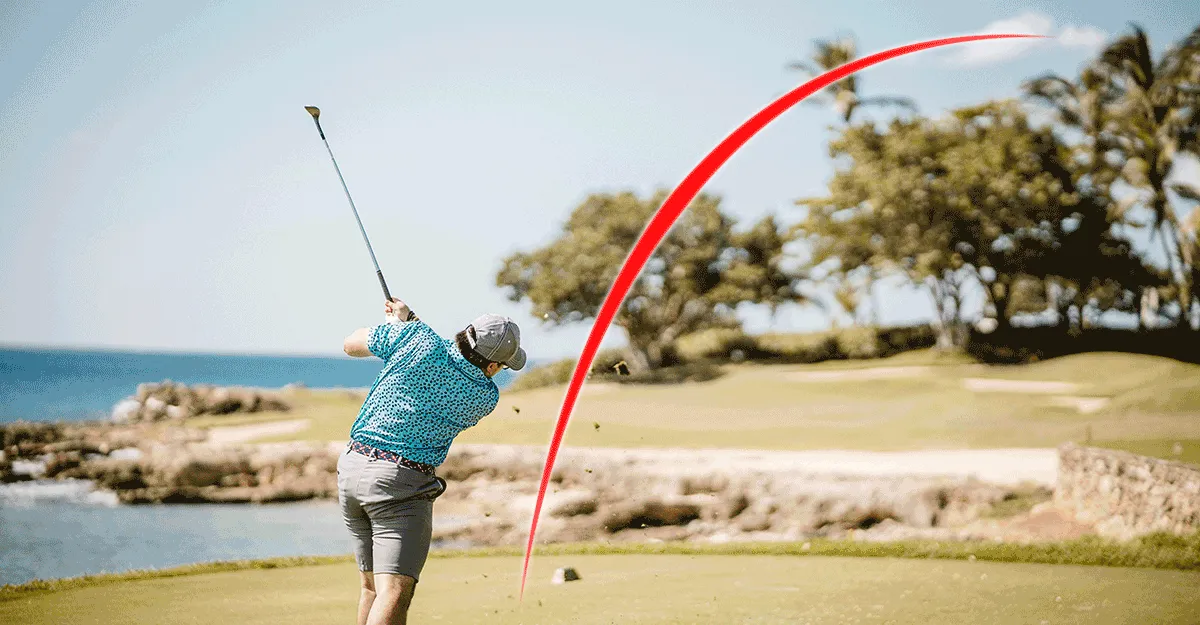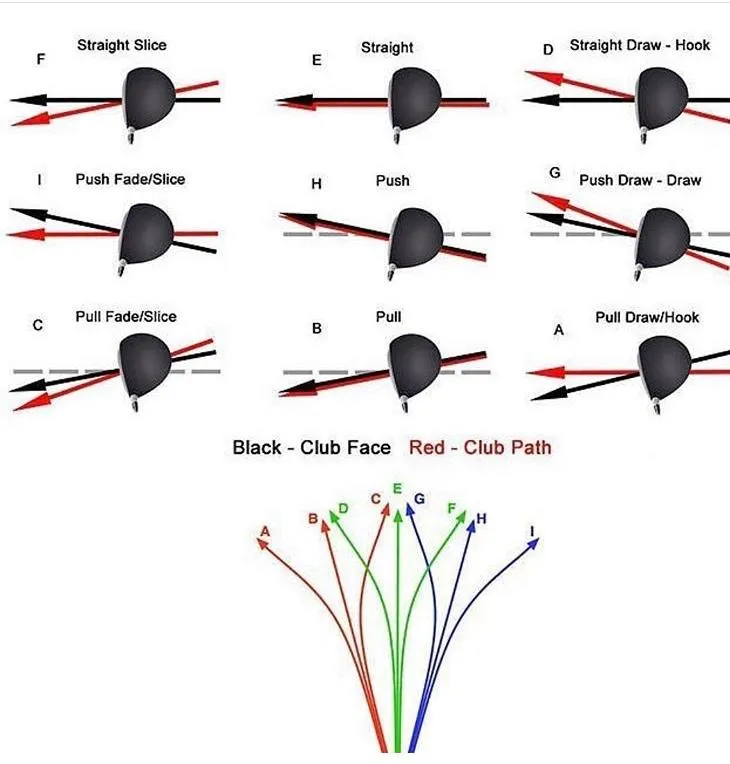
You booked an hour, the bay lights up, and the first ball peels off to the right like it’s allergic to the fairway. We’ve all been there. The greatest benefit of indoor golf is that you don’t have to guess why it happened. Your simulator gives you a ton of data, and if you know what to look for, you can calm that slice or hook in a single session. You won’t get that at your local Topgolf
What This Guide Covers
- Why the ball starts where it does and curves the way it does
- The three screen golf numbers that matter most and how to use them without overthinking
- A clear plan if you slice or if you hook
- Some of the best indoor golf drills you can do whether you’re a beginner or more advanced
Curing Your Slice (or Hook): Swing Metrics To Watch
-
Curve (often called Spin Axis): This tells you if the ball is bending right or left. More right bend = slice/fade. More left bend = draw/hook. Your goal isn’t a perfect zero; it’s less curve than you had before. If you see “spin axis slice” numbers shrink toward neutral, you’re on the right track.
-
Face vs. Swing Direction (often shown as Face-to-Path): Think of this as the “why.” If the clubface is pointing more right than your swing is traveling (for a right-handed golfer), the ball tends to curve right (slice). If the face points more left than the swing, the ball tends to curve left (hook).
-
Contact Point (Impact Location): Also known as gear effect. Heel hits add slice curve. Toe hits add hook curve. Even a pretty good swing can curve if you miss the center.
Step 1 — Why the Ball Curves (Face + Path)
Two things decide almost everything at impact: where the clubface points and the direction the club is traveling. Picture two arrows. The black one is the face; the red one is your swing path. Change those two arrows, and the flight changes.

Here’s how to read that picture like a coach:
-
Start line follows the face. If your face points a hair right, the ball usually starts right. If it points a hair left, it starts left. That’s why you’ll see “push” and “pull” starts in the diagram.
-
Curve depends on face vs. path.
- Face more right than your swing? Expect the ball to curve right (slice/fade).
- Face more left than your swing? Expect the ball to curve left (draw/hook).
-
Contact tweaks the story. A heel strike tends to twist the face open (more slice). A toe strike tends to twist it closed (more hook). That’s why two swings that feel identical can curve differently.
You don’t need to memorize letters on the graphic. Just remember: face sets the start, face-to-path sets the curve, contact can exaggerate both.
Step 2 — If You Slice (ball curves right for right-handed golfers)
Let’s keep this simple. Your mission is to close the gap between the face and the path or move contact closer to the center. A couple of small nudges are plenty.
A. Tiny face tweak
- See two knuckles on your lead hand at address or rotate your lead wrist a touch “down” earlier in the downswing.
- If that feels weird, rehearse a half-swing where the logo on your glove faces the ground past impact. You’re teaching the face to arrive a tick less open.
B. Nudge the swing direction
- Imagine swinging to right-center field instead of across your body.
- Lay an alignment stick (or towel) just outside the ball, pointed slightly right of target, and make your swing trace it.
C. Center the strike
- Chronic heel contact? Stand a half-shoe farther from the ball or move the ball a whisper forward.
- Use impact stickers or a dry-erase dot on the ball. Your goal is more center hits, not perfection.
D. What to watch on-screen
- Curve values trending less right than before.
- Face and path numbers inching closer together (even if they don’t match).
- Contact (if your unit shows it) moving away from the heel.
E. Two quick, bay-friendly drills
-
“Miss the box” drill: Place an empty sleeve of balls just outside the clubhead at address. Make swings that miss the box and clip the center. You’ll feel a gentler, more inside-to-out path.
-
Three-ball progression: Normal setup → close face a hair → swing toward right-center. Hit three balls, then check the averages. Keep the feel that moved the curve toward neutral.
F. Common questions you might silently ask yourself
-
“I tried to swing more inside, but it still sliced.”
You likely moved the path without the face. Keep your new path idea but add the tiny face tweak.
-
“The first shot fixed it; the next three ballooned right again.”
Glance at contact—many ballooning slices are heel-side hits. Center a few and watch them settle.
Step 3 — If You Hook (ball curves left for right-handed golfers)
Different miss, same approach: bring face and path closer together and calm toe-side contact.
A. Tiny face tweak
- Slightly weaken the lead-hand grip (turn it counter-clockwise a touch) or feel like you’re holding the face off through impact.
- Another feel that works for many players: keep the logo on your glove facing the target a fraction longer.
B. Nudge the swing direction
- Picture sending the club toward left-center field.
- Place a towel just inside the ball and make swings that miss it; that encourages a less in-to-out move.
C. Center the strike
- Chronic toe strikes? Stand a fraction closer to the ball or move the ball slightly forward.
- Mark a small dot on the ball and try to cover it with the middle of the face.
D. What to watch on-screen
- Curve numbers showing less left bend than before.
- Face and path inching closer to one another (toward neutral).
- Strike shifting away from the toe.
E. Two quick, bay-friendly drills
-
Goalpost drill: Set two tees four inches ahead of the ball, slightly left of your target line, like uprights. Swing “through the posts” to calm the hook.
-
Five-ball “hold” set: For five swings, feel like the clubface is gently staying with the target longer. Check if the curve softens.
F. Common questions
-
“I toned down the hook but started the ball way right.”
That’s the face setting the start line. Keep your calmer release but aim or align so the face points nearer your target at address.
-
“One shot goes straight, the next dives left.”
That’s often toe contact sneaking in. A tiny setup change—closer stance or slightly higher tee—can help you find center again.
Quick Wins You Can Feel Today
These are small and boring, which is exactly why they work.
-
Ball position check: If it’s too far forward, you may leave the face open (slice). Too far back, you may shut it (hook). For driver, try inside the lead heel. For mid-irons, a ball or two forward of center.
-
Grip pressure audit: A clenched grip makes the face twitchy. Think firm but not glued—like holding a tube of toothpaste without squeezing it.
-
Eyeline and shoulders: If your shoulders point left, many players swing left (slice). If they point right, many swing right (hook). Square them to your target line and re-test.
-
Five-ball sprints: Make one small change, hit five balls, and check the averages. If the curve moved the right way, keep it. If not, revert and try a different tiny tweak. Short sprints keep you from guessing.
-
Use your “neutral club.” Most golfers have one club that behaves—often a 7-iron. Make your change with that club first to build confidence, then transfer the feel to driver.
-
Finish checkpoints: A held, balanced finish usually means your rhythm was good. If you’re falling left or right, your curve often grows. Smooth beats tense.
Mini reminder: Your simulator doesn’t need to congratulate you with a perfect zero. If the ball is bending less, you’re winning.
When to Ask for Help
If you’ve made a couple of sensible tweaks and your averages are improving, that’s a great moment for a short lesson. However the best golfers have a swing that’s repeatable and consistent. If you’re struggling even after trying the above, it might be a good idea to take a couple of indoor golf lessons at your local indoor golf facility. Indoor golf training has the benefit of being available year round, so you can work on your game whether it’s hot, cold, rainy, or snowy.
Wrap-Up
Indoor practice takes the guesswork out of golf. The golf simulator can detect a slice (or hook) and give you hints about why that happened. Use the picture above to keep the story straight in your head: face sets the start, face-to-path sets the curve, contact can amplify either one. From there, it’s about tiny, sensible changes:
- A small face tweak.
- A gentle nudge to your swing direction.
- A move toward center contact.
Watch for less curve and closer numbers, not perfection. That’s how you turn a streak of slices into a row of playable fades, or a runaway hook into a tidy draw. Remember that golf is not a game of perfect, but rather a game of good enough. Even pros can’t hit 100% perfect shots!
Want to put this to work today? Find a screen golf near you, book a bay, bring this guide, and run a five-ball sprint with one change at a time. Ten minutes later you’ll have cleaner numbers and a straighter flight—plus the kind of confidence that travels outdoors.
